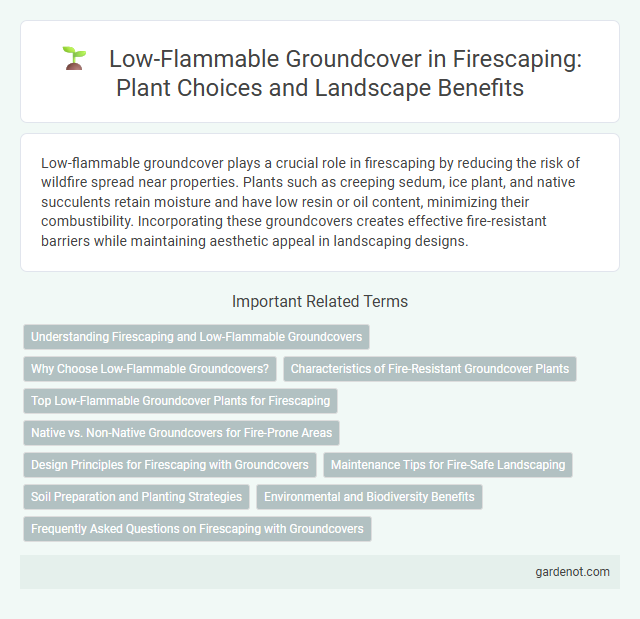Low-flammable groundcover plays a crucial role in firescaping by reducing the risk of wildfire spread near properties. Plants such as creeping sedum, ice plant, and native succulents retain moisture and have low resin or oil content, minimizing their combustibility. Incorporating these groundcovers creates effective fire-resistant barriers while maintaining aesthetic appeal in landscaping designs.
Understanding Firescaping and Low-Flammable Groundcovers
Low-flammable groundcovers play a crucial role in firescaping by reducing the risk of fire spreading across landscapes. Plants such as sedum, ice plant, and creeping thyme possess high moisture content and low resin levels, making them less likely to ignite. Strategic placement of these groundcovers around homes and structures can effectively create defensible space and reduce wildfire hazards.
Why Choose Low-Flammable Groundcovers?
Low-flammable groundcovers significantly reduce the risk of wildfire spread by limiting combustible materials near structures and landscapes. These groundcovers retain moisture and resist ignition, creating effective firebreaks that protect properties and enhance overall landscape safety. Using low-flammable species contributes to sustainable fire management and aligns with firewise landscaping practices.
Characteristics of Fire-Resistant Groundcover Plants
Fire-resistant groundcover plants typically have high moisture content, thick leaves, and low volatile oils, which reduce their flammability and ability to ignite quickly. These plants often exhibit dense, compact growth patterns that minimize airflow and limit the spread of flames across the surface. Common examples include succulents, certain varieties of sedum, and native grasses adapted to fire-prone environments, all contributing to effective firescaping by creating natural firebreaks and reducing wildfire risk.
Top Low-Flammable Groundcover Plants for Firescaping
Top low-flammable groundcover plants for firescaping include creeping thyme, sedum, and ice plant, known for their high moisture content and minimal resin levels that reduce fire risk. These plants effectively create green, fire-resistant barriers around homes, slowing fire spread by maintaining low combustibility in garden beds. Their drought tolerance and low maintenance requirements make them ideal choices for sustainable, fire-safe landscaping in fire-prone regions.
Native vs. Non-Native Groundcovers for Fire-Prone Areas
Native groundcovers such as creeping mahonia and wild strawberry are ideal for fire-prone areas due to their low flammability and adaptability to local climates, reducing wildfire risks. Non-native groundcovers like mondo grass and ice plant may also offer fire-resistant properties but often require more water and maintenance, which can increase fire hazards under drought conditions. Selecting native species supports ecosystem resilience and enhances the effectiveness of a defensible space in firescaping strategies.
Design Principles for Firescaping with Groundcovers
Selecting low-flammable groundcovers is essential for effective firescaping, as these plants reduce the risk of wildfire ignition and spread around properties. Design principles emphasize creating strategically placed fuel breaks by incorporating drought-tolerant, moisture-rich species like succulents and certain grasses that maintain high moisture content and minimize combustible material. Proper spacing, layering with less flammable plants, and regular maintenance to remove dead debris enhance groundcover effectiveness in mitigating fire hazards.
Maintenance Tips for Fire-Safe Landscaping
Low-flammable groundcovers such as sedums, ice plants, and creeping thyme enhance fire-safe landscaping by reducing combustible materials near structures. Regular maintenance includes removing dead leaves and stems, pruning to maintain low plant density, and irrigating to keep plants healthy and moist, minimizing fire risk. Consistent debris clearance and avoiding accumulation of dry organic material ensure these groundcovers effectively act as a fire-resistant barrier.
Soil Preparation and Planting Strategies
Low-flammable groundcover selection significantly reduces wildfire risk by creating fire-resistant barriers around properties. Proper soil preparation involves aerating soil, adding organic compost, and ensuring adequate drainage to support healthy plant root development and moisture retention. Planting strategies recommend spacing groundcovers to minimize gaps, combining species with high moisture content, and maintaining consistent irrigation to enhance fire resistance and soil stability.
Environmental and Biodiversity Benefits
Low-flammable groundcovers such as creeping thyme and sedum reduce wildfire risk while supporting local ecosystems by providing habitat and food sources for pollinators like bees and butterflies. These drought-tolerant plants improve soil health through erosion control and organic matter contribution, enhancing biodiversity and ecosystem resilience. Choosing native, low-flammable groundcovers integrates fire safety with environmental stewardship and biodiversity conservation.
Frequently Asked Questions on Firescaping with Groundcovers
Low-flammable groundcovers such as creeping thyme, sedum, and ice plant are ideal choices for firescaping due to their ability to resist ignition and reduce fire spread near structures. These drought-tolerant plants maintain moisture levels and create a defensible space, effectively minimizing fuel for wildfires. Proper spacing and regular maintenance of these groundcovers enhance their fire-resistant properties and promote landscape safety.
Low-flammable groundcover Infographic

 gardenot.com
gardenot.com